Nursing Assignment: Critical Analysis of Smart Drug Use in Students
VerifiedAdded on 2020/05/01
|12
|2674
|129
Essay
AI Summary
This nursing assignment critically evaluates the use of smart drugs among university students, focusing on a case study of a student named Wasim. The essay assesses two research articles, one qualitative and one quantitative, examining the evidence related to the use of stimulants for academic performance enhancement. It analyzes the authorship, research aims, design, and findings of each study, highlighting strengths and weaknesses. The assignment then discusses barriers to applying the evidence, such as discrepancies in data and potential biases. It also explores the development and alignment of a PICO question (Population, Intervention, Comparator, Outcome) with the research findings, ultimately concluding that while stimulants can improve academic performance, their use outside of medical necessity, as in Wasim's friends' case, may be harmful. The assignment emphasizes the importance of evidence-based practice and the limitations of both qualitative and quantitative research in this context.
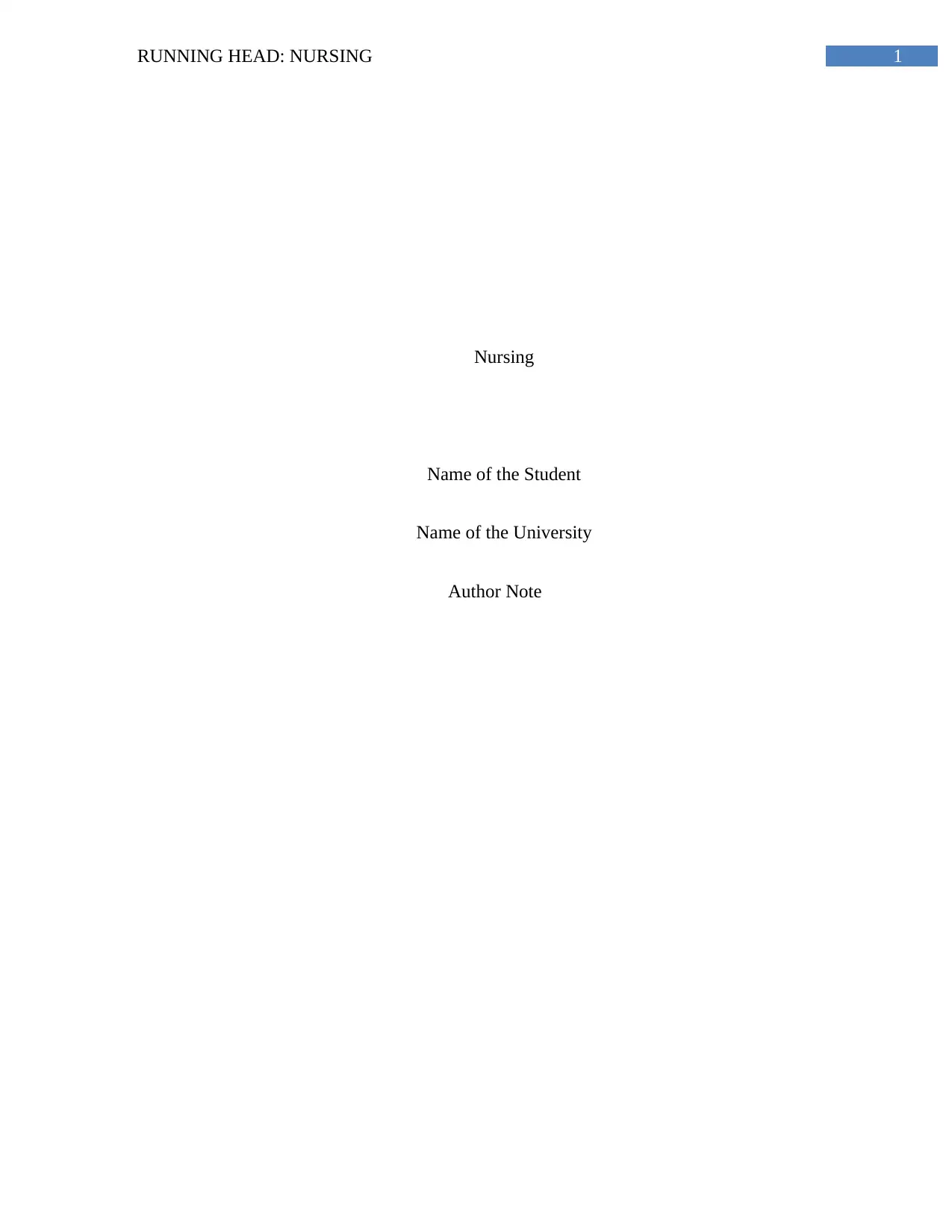
1RUNNING HEAD: NURSING
Nursing
Name of the Student
Name of the University
Author Note
Nursing
Name of the Student
Name of the University
Author Note
Paraphrase This Document
Need a fresh take? Get an instant paraphrase of this document with our AI Paraphraser
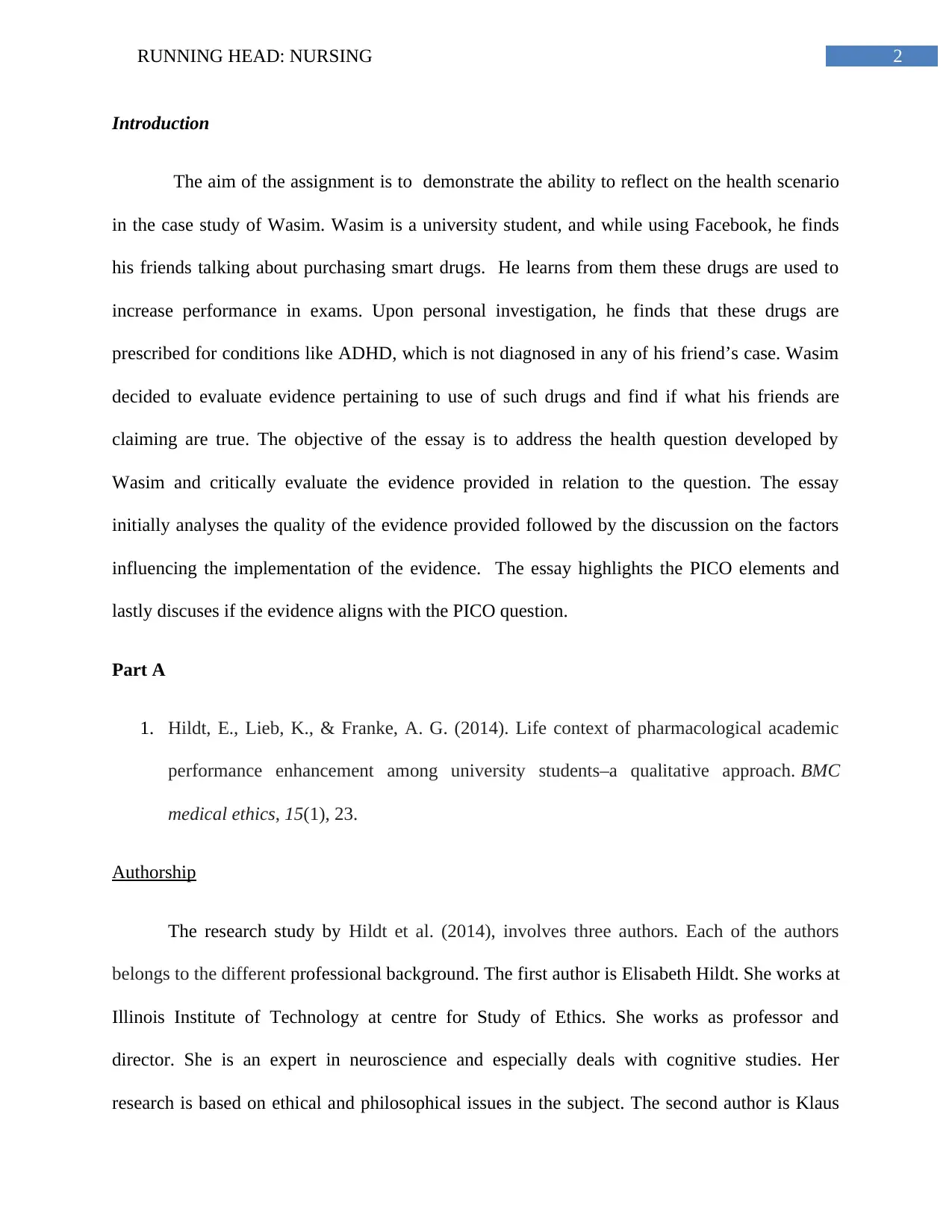
2RUNNING HEAD: NURSING
Introduction
The aim of the assignment is to demonstrate the ability to reflect on the health scenario
in the case study of Wasim. Wasim is a university student, and while using Facebook, he finds
his friends talking about purchasing smart drugs. He learns from them these drugs are used to
increase performance in exams. Upon personal investigation, he finds that these drugs are
prescribed for conditions like ADHD, which is not diagnosed in any of his friend’s case. Wasim
decided to evaluate evidence pertaining to use of such drugs and find if what his friends are
claiming are true. The objective of the essay is to address the health question developed by
Wasim and critically evaluate the evidence provided in relation to the question. The essay
initially analyses the quality of the evidence provided followed by the discussion on the factors
influencing the implementation of the evidence. The essay highlights the PICO elements and
lastly discuses if the evidence aligns with the PICO question.
Part A
1. Hildt, E., Lieb, K., & Franke, A. G. (2014). Life context of pharmacological academic
performance enhancement among university students–a qualitative approach. BMC
medical ethics, 15(1), 23.
Authorship
The research study by Hildt et al. (2014), involves three authors. Each of the authors
belongs to the different professional background. The first author is Elisabeth Hildt. She works at
Illinois Institute of Technology at centre for Study of Ethics. She works as professor and
director. She is an expert in neuroscience and especially deals with cognitive studies. Her
research is based on ethical and philosophical issues in the subject. The second author is Klaus
Introduction
The aim of the assignment is to demonstrate the ability to reflect on the health scenario
in the case study of Wasim. Wasim is a university student, and while using Facebook, he finds
his friends talking about purchasing smart drugs. He learns from them these drugs are used to
increase performance in exams. Upon personal investigation, he finds that these drugs are
prescribed for conditions like ADHD, which is not diagnosed in any of his friend’s case. Wasim
decided to evaluate evidence pertaining to use of such drugs and find if what his friends are
claiming are true. The objective of the essay is to address the health question developed by
Wasim and critically evaluate the evidence provided in relation to the question. The essay
initially analyses the quality of the evidence provided followed by the discussion on the factors
influencing the implementation of the evidence. The essay highlights the PICO elements and
lastly discuses if the evidence aligns with the PICO question.
Part A
1. Hildt, E., Lieb, K., & Franke, A. G. (2014). Life context of pharmacological academic
performance enhancement among university students–a qualitative approach. BMC
medical ethics, 15(1), 23.
Authorship
The research study by Hildt et al. (2014), involves three authors. Each of the authors
belongs to the different professional background. The first author is Elisabeth Hildt. She works at
Illinois Institute of Technology at centre for Study of Ethics. She works as professor and
director. She is an expert in neuroscience and especially deals with cognitive studies. Her
research is based on ethical and philosophical issues in the subject. The second author is Klaus
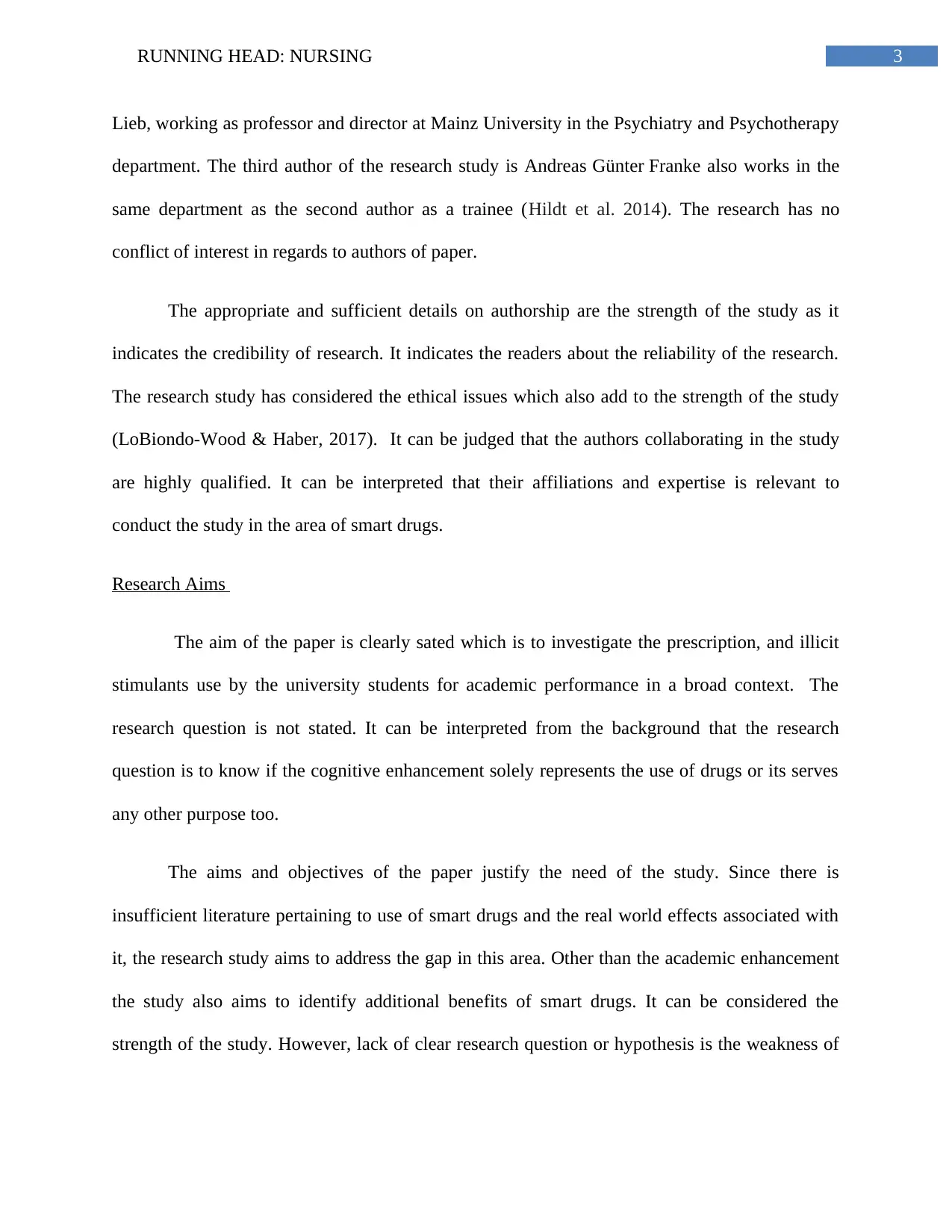
3RUNNING HEAD: NURSING
Lieb, working as professor and director at Mainz University in the Psychiatry and Psychotherapy
department. The third author of the research study is Andreas Günter Franke also works in the
same department as the second author as a trainee (Hildt et al. 2014). The research has no
conflict of interest in regards to authors of paper.
The appropriate and sufficient details on authorship are the strength of the study as it
indicates the credibility of research. It indicates the readers about the reliability of the research.
The research study has considered the ethical issues which also add to the strength of the study
(LoBiondo-Wood & Haber, 2017). It can be judged that the authors collaborating in the study
are highly qualified. It can be interpreted that their affiliations and expertise is relevant to
conduct the study in the area of smart drugs.
Research Aims
The aim of the paper is clearly sated which is to investigate the prescription, and illicit
stimulants use by the university students for academic performance in a broad context. The
research question is not stated. It can be interpreted from the background that the research
question is to know if the cognitive enhancement solely represents the use of drugs or its serves
any other purpose too.
The aims and objectives of the paper justify the need of the study. Since there is
insufficient literature pertaining to use of smart drugs and the real world effects associated with
it, the research study aims to address the gap in this area. Other than the academic enhancement
the study also aims to identify additional benefits of smart drugs. It can be considered the
strength of the study. However, lack of clear research question or hypothesis is the weakness of
Lieb, working as professor and director at Mainz University in the Psychiatry and Psychotherapy
department. The third author of the research study is Andreas Günter Franke also works in the
same department as the second author as a trainee (Hildt et al. 2014). The research has no
conflict of interest in regards to authors of paper.
The appropriate and sufficient details on authorship are the strength of the study as it
indicates the credibility of research. It indicates the readers about the reliability of the research.
The research study has considered the ethical issues which also add to the strength of the study
(LoBiondo-Wood & Haber, 2017). It can be judged that the authors collaborating in the study
are highly qualified. It can be interpreted that their affiliations and expertise is relevant to
conduct the study in the area of smart drugs.
Research Aims
The aim of the paper is clearly sated which is to investigate the prescription, and illicit
stimulants use by the university students for academic performance in a broad context. The
research question is not stated. It can be interpreted from the background that the research
question is to know if the cognitive enhancement solely represents the use of drugs or its serves
any other purpose too.
The aims and objectives of the paper justify the need of the study. Since there is
insufficient literature pertaining to use of smart drugs and the real world effects associated with
it, the research study aims to address the gap in this area. Other than the academic enhancement
the study also aims to identify additional benefits of smart drugs. It can be considered the
strength of the study. However, lack of clear research question or hypothesis is the weakness of
⊘ This is a preview!⊘
Do you want full access?
Subscribe today to unlock all pages.

Trusted by 1+ million students worldwide
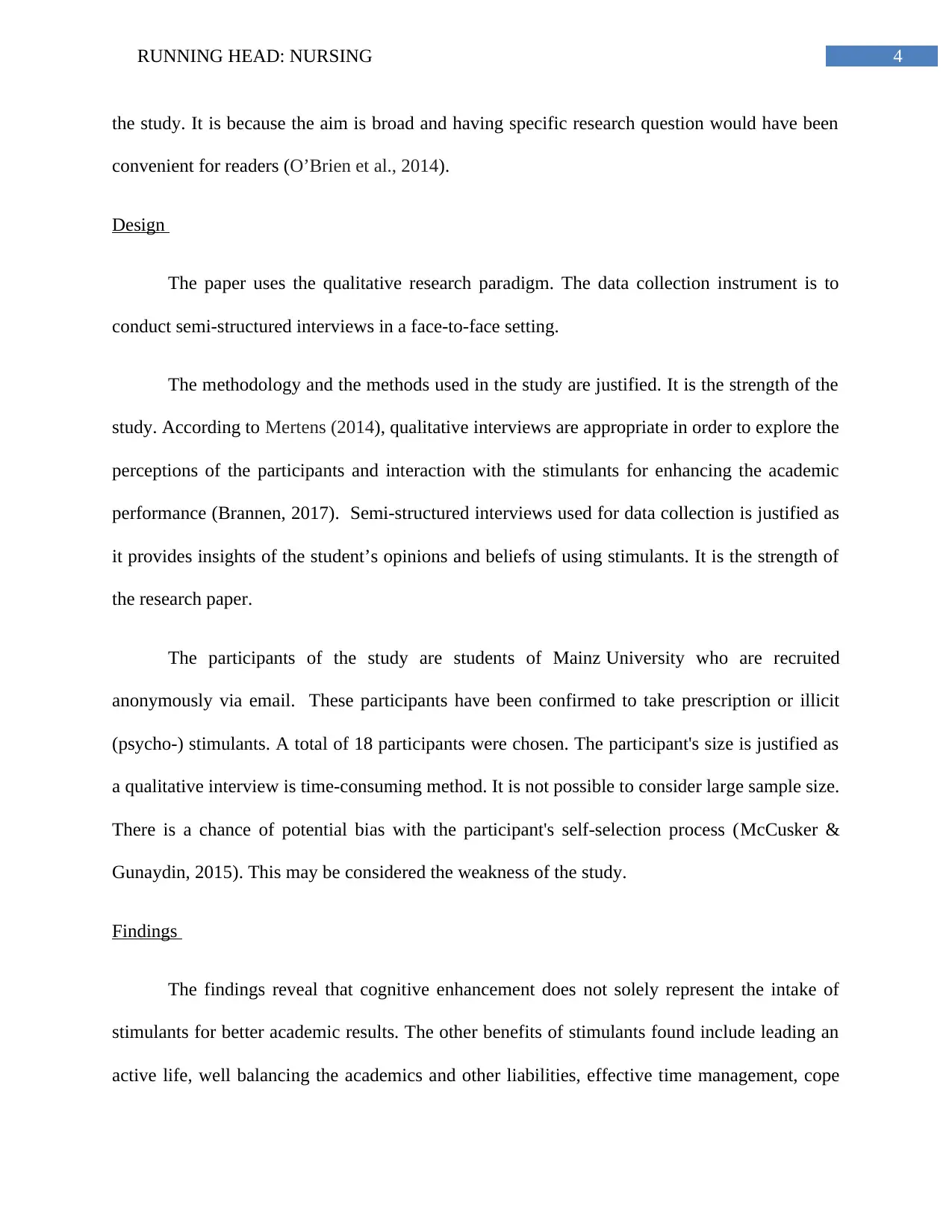
4RUNNING HEAD: NURSING
the study. It is because the aim is broad and having specific research question would have been
convenient for readers (O’Brien et al., 2014).
Design
The paper uses the qualitative research paradigm. The data collection instrument is to
conduct semi-structured interviews in a face-to-face setting.
The methodology and the methods used in the study are justified. It is the strength of the
study. According to Mertens (2014), qualitative interviews are appropriate in order to explore the
perceptions of the participants and interaction with the stimulants for enhancing the academic
performance (Brannen, 2017). Semi-structured interviews used for data collection is justified as
it provides insights of the student’s opinions and beliefs of using stimulants. It is the strength of
the research paper.
The participants of the study are students of Mainz University who are recruited
anonymously via email. These participants have been confirmed to take prescription or illicit
(psycho-) stimulants. A total of 18 participants were chosen. The participant's size is justified as
a qualitative interview is time-consuming method. It is not possible to consider large sample size.
There is a chance of potential bias with the participant's self-selection process (McCusker &
Gunaydin, 2015). This may be considered the weakness of the study.
Findings
The findings reveal that cognitive enhancement does not solely represent the intake of
stimulants for better academic results. The other benefits of stimulants found include leading an
active life, well balancing the academics and other liabilities, effective time management, cope
the study. It is because the aim is broad and having specific research question would have been
convenient for readers (O’Brien et al., 2014).
Design
The paper uses the qualitative research paradigm. The data collection instrument is to
conduct semi-structured interviews in a face-to-face setting.
The methodology and the methods used in the study are justified. It is the strength of the
study. According to Mertens (2014), qualitative interviews are appropriate in order to explore the
perceptions of the participants and interaction with the stimulants for enhancing the academic
performance (Brannen, 2017). Semi-structured interviews used for data collection is justified as
it provides insights of the student’s opinions and beliefs of using stimulants. It is the strength of
the research paper.
The participants of the study are students of Mainz University who are recruited
anonymously via email. These participants have been confirmed to take prescription or illicit
(psycho-) stimulants. A total of 18 participants were chosen. The participant's size is justified as
a qualitative interview is time-consuming method. It is not possible to consider large sample size.
There is a chance of potential bias with the participant's self-selection process (McCusker &
Gunaydin, 2015). This may be considered the weakness of the study.
Findings
The findings reveal that cognitive enhancement does not solely represent the intake of
stimulants for better academic results. The other benefits of stimulants found include leading an
active life, well balancing the academics and other liabilities, effective time management, cope
Paraphrase This Document
Need a fresh take? Get an instant paraphrase of this document with our AI Paraphraser
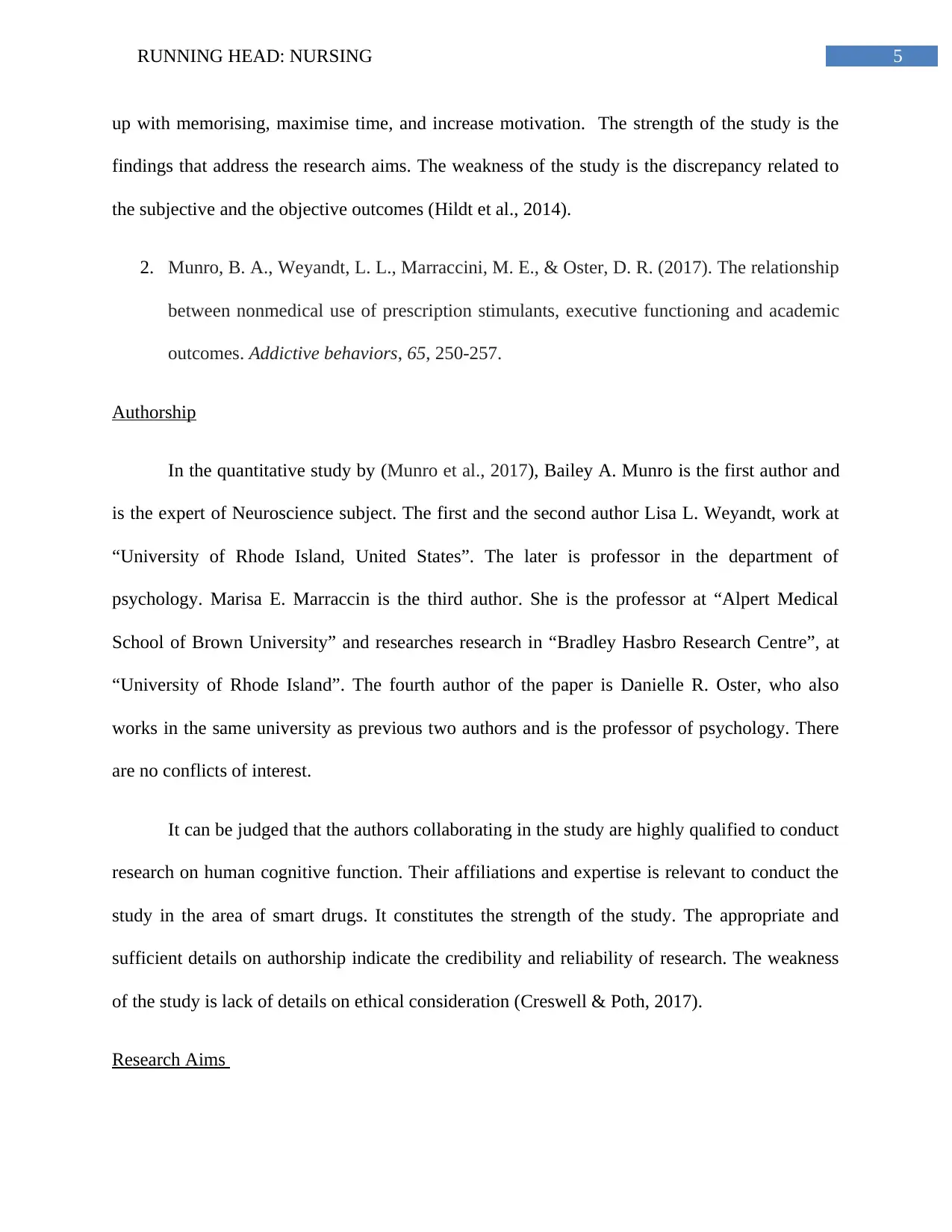
5RUNNING HEAD: NURSING
up with memorising, maximise time, and increase motivation. The strength of the study is the
findings that address the research aims. The weakness of the study is the discrepancy related to
the subjective and the objective outcomes (Hildt et al., 2014).
2. Munro, B. A., Weyandt, L. L., Marraccini, M. E., & Oster, D. R. (2017). The relationship
between nonmedical use of prescription stimulants, executive functioning and academic
outcomes. Addictive behaviors, 65, 250-257.
Authorship
In the quantitative study by (Munro et al., 2017), Bailey A. Munro is the first author and
is the expert of Neuroscience subject. The first and the second author Lisa L. Weyandt, work at
“University of Rhode Island, United States”. The later is professor in the department of
psychology. Marisa E. Marraccin is the third author. She is the professor at “Alpert Medical
School of Brown University” and researches research in “Bradley Hasbro Research Centre”, at
“University of Rhode Island”. The fourth author of the paper is Danielle R. Oster, who also
works in the same university as previous two authors and is the professor of psychology. There
are no conflicts of interest.
It can be judged that the authors collaborating in the study are highly qualified to conduct
research on human cognitive function. Their affiliations and expertise is relevant to conduct the
study in the area of smart drugs. It constitutes the strength of the study. The appropriate and
sufficient details on authorship indicate the credibility and reliability of research. The weakness
of the study is lack of details on ethical consideration (Creswell & Poth, 2017).
Research Aims
up with memorising, maximise time, and increase motivation. The strength of the study is the
findings that address the research aims. The weakness of the study is the discrepancy related to
the subjective and the objective outcomes (Hildt et al., 2014).
2. Munro, B. A., Weyandt, L. L., Marraccini, M. E., & Oster, D. R. (2017). The relationship
between nonmedical use of prescription stimulants, executive functioning and academic
outcomes. Addictive behaviors, 65, 250-257.
Authorship
In the quantitative study by (Munro et al., 2017), Bailey A. Munro is the first author and
is the expert of Neuroscience subject. The first and the second author Lisa L. Weyandt, work at
“University of Rhode Island, United States”. The later is professor in the department of
psychology. Marisa E. Marraccin is the third author. She is the professor at “Alpert Medical
School of Brown University” and researches research in “Bradley Hasbro Research Centre”, at
“University of Rhode Island”. The fourth author of the paper is Danielle R. Oster, who also
works in the same university as previous two authors and is the professor of psychology. There
are no conflicts of interest.
It can be judged that the authors collaborating in the study are highly qualified to conduct
research on human cognitive function. Their affiliations and expertise is relevant to conduct the
study in the area of smart drugs. It constitutes the strength of the study. The appropriate and
sufficient details on authorship indicate the credibility and reliability of research. The weakness
of the study is lack of details on ethical consideration (Creswell & Poth, 2017).
Research Aims
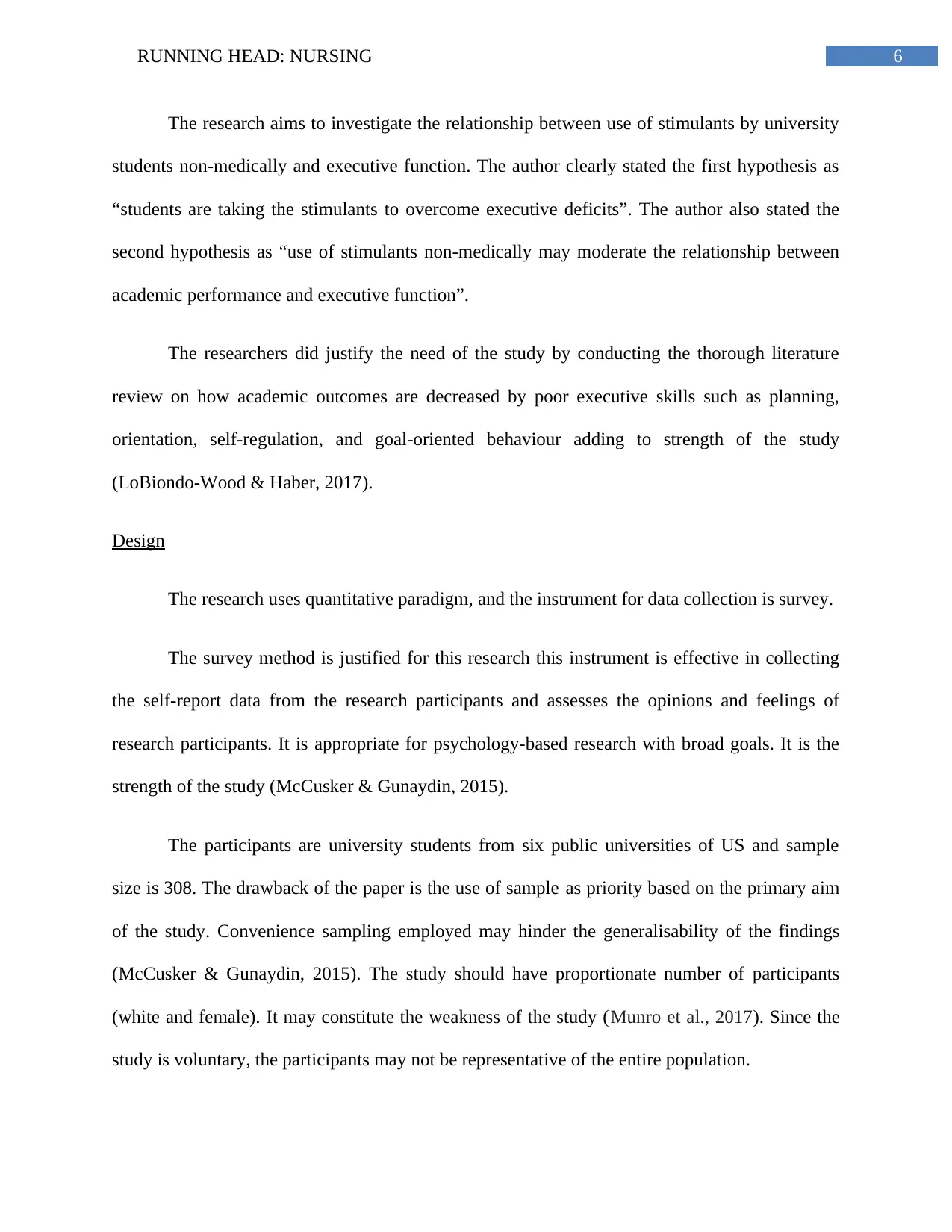
6RUNNING HEAD: NURSING
The research aims to investigate the relationship between use of stimulants by university
students non-medically and executive function. The author clearly stated the first hypothesis as
“students are taking the stimulants to overcome executive deficits”. The author also stated the
second hypothesis as “use of stimulants non-medically may moderate the relationship between
academic performance and executive function”.
The researchers did justify the need of the study by conducting the thorough literature
review on how academic outcomes are decreased by poor executive skills such as planning,
orientation, self-regulation, and goal-oriented behaviour adding to strength of the study
(LoBiondo-Wood & Haber, 2017).
Design
The research uses quantitative paradigm, and the instrument for data collection is survey.
The survey method is justified for this research this instrument is effective in collecting
the self-report data from the research participants and assesses the opinions and feelings of
research participants. It is appropriate for psychology-based research with broad goals. It is the
strength of the study (McCusker & Gunaydin, 2015).
The participants are university students from six public universities of US and sample
size is 308. The drawback of the paper is the use of sample as priority based on the primary aim
of the study. Convenience sampling employed may hinder the generalisability of the findings
(McCusker & Gunaydin, 2015). The study should have proportionate number of participants
(white and female). It may constitute the weakness of the study (Munro et al., 2017). Since the
study is voluntary, the participants may not be representative of the entire population.
The research aims to investigate the relationship between use of stimulants by university
students non-medically and executive function. The author clearly stated the first hypothesis as
“students are taking the stimulants to overcome executive deficits”. The author also stated the
second hypothesis as “use of stimulants non-medically may moderate the relationship between
academic performance and executive function”.
The researchers did justify the need of the study by conducting the thorough literature
review on how academic outcomes are decreased by poor executive skills such as planning,
orientation, self-regulation, and goal-oriented behaviour adding to strength of the study
(LoBiondo-Wood & Haber, 2017).
Design
The research uses quantitative paradigm, and the instrument for data collection is survey.
The survey method is justified for this research this instrument is effective in collecting
the self-report data from the research participants and assesses the opinions and feelings of
research participants. It is appropriate for psychology-based research with broad goals. It is the
strength of the study (McCusker & Gunaydin, 2015).
The participants are university students from six public universities of US and sample
size is 308. The drawback of the paper is the use of sample as priority based on the primary aim
of the study. Convenience sampling employed may hinder the generalisability of the findings
(McCusker & Gunaydin, 2015). The study should have proportionate number of participants
(white and female). It may constitute the weakness of the study (Munro et al., 2017). Since the
study is voluntary, the participants may not be representative of the entire population.
⊘ This is a preview!⊘
Do you want full access?
Subscribe today to unlock all pages.

Trusted by 1+ million students worldwide
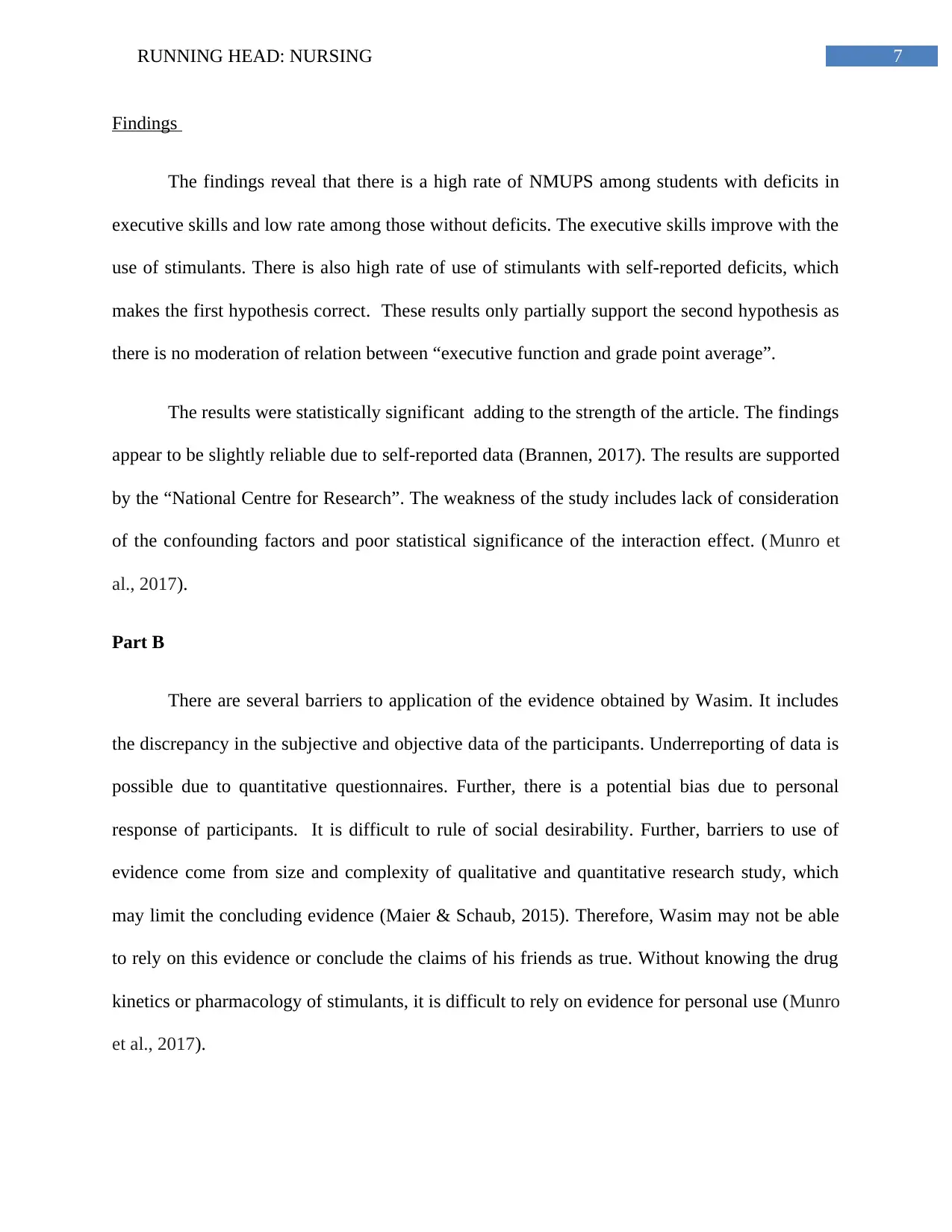
7RUNNING HEAD: NURSING
Findings
The findings reveal that there is a high rate of NMUPS among students with deficits in
executive skills and low rate among those without deficits. The executive skills improve with the
use of stimulants. There is also high rate of use of stimulants with self-reported deficits, which
makes the first hypothesis correct. These results only partially support the second hypothesis as
there is no moderation of relation between “executive function and grade point average”.
The results were statistically significant adding to the strength of the article. The findings
appear to be slightly reliable due to self-reported data (Brannen, 2017). The results are supported
by the “National Centre for Research”. The weakness of the study includes lack of consideration
of the confounding factors and poor statistical significance of the interaction effect. (Munro et
al., 2017).
Part B
There are several barriers to application of the evidence obtained by Wasim. It includes
the discrepancy in the subjective and objective data of the participants. Underreporting of data is
possible due to quantitative questionnaires. Further, there is a potential bias due to personal
response of participants. It is difficult to rule of social desirability. Further, barriers to use of
evidence come from size and complexity of qualitative and quantitative research study, which
may limit the concluding evidence (Maier & Schaub, 2015). Therefore, Wasim may not be able
to rely on this evidence or conclude the claims of his friends as true. Without knowing the drug
kinetics or pharmacology of stimulants, it is difficult to rely on evidence for personal use (Munro
et al., 2017).
Findings
The findings reveal that there is a high rate of NMUPS among students with deficits in
executive skills and low rate among those without deficits. The executive skills improve with the
use of stimulants. There is also high rate of use of stimulants with self-reported deficits, which
makes the first hypothesis correct. These results only partially support the second hypothesis as
there is no moderation of relation between “executive function and grade point average”.
The results were statistically significant adding to the strength of the article. The findings
appear to be slightly reliable due to self-reported data (Brannen, 2017). The results are supported
by the “National Centre for Research”. The weakness of the study includes lack of consideration
of the confounding factors and poor statistical significance of the interaction effect. (Munro et
al., 2017).
Part B
There are several barriers to application of the evidence obtained by Wasim. It includes
the discrepancy in the subjective and objective data of the participants. Underreporting of data is
possible due to quantitative questionnaires. Further, there is a potential bias due to personal
response of participants. It is difficult to rule of social desirability. Further, barriers to use of
evidence come from size and complexity of qualitative and quantitative research study, which
may limit the concluding evidence (Maier & Schaub, 2015). Therefore, Wasim may not be able
to rely on this evidence or conclude the claims of his friends as true. Without knowing the drug
kinetics or pharmacology of stimulants, it is difficult to rely on evidence for personal use (Munro
et al., 2017).
Paraphrase This Document
Need a fresh take? Get an instant paraphrase of this document with our AI Paraphraser
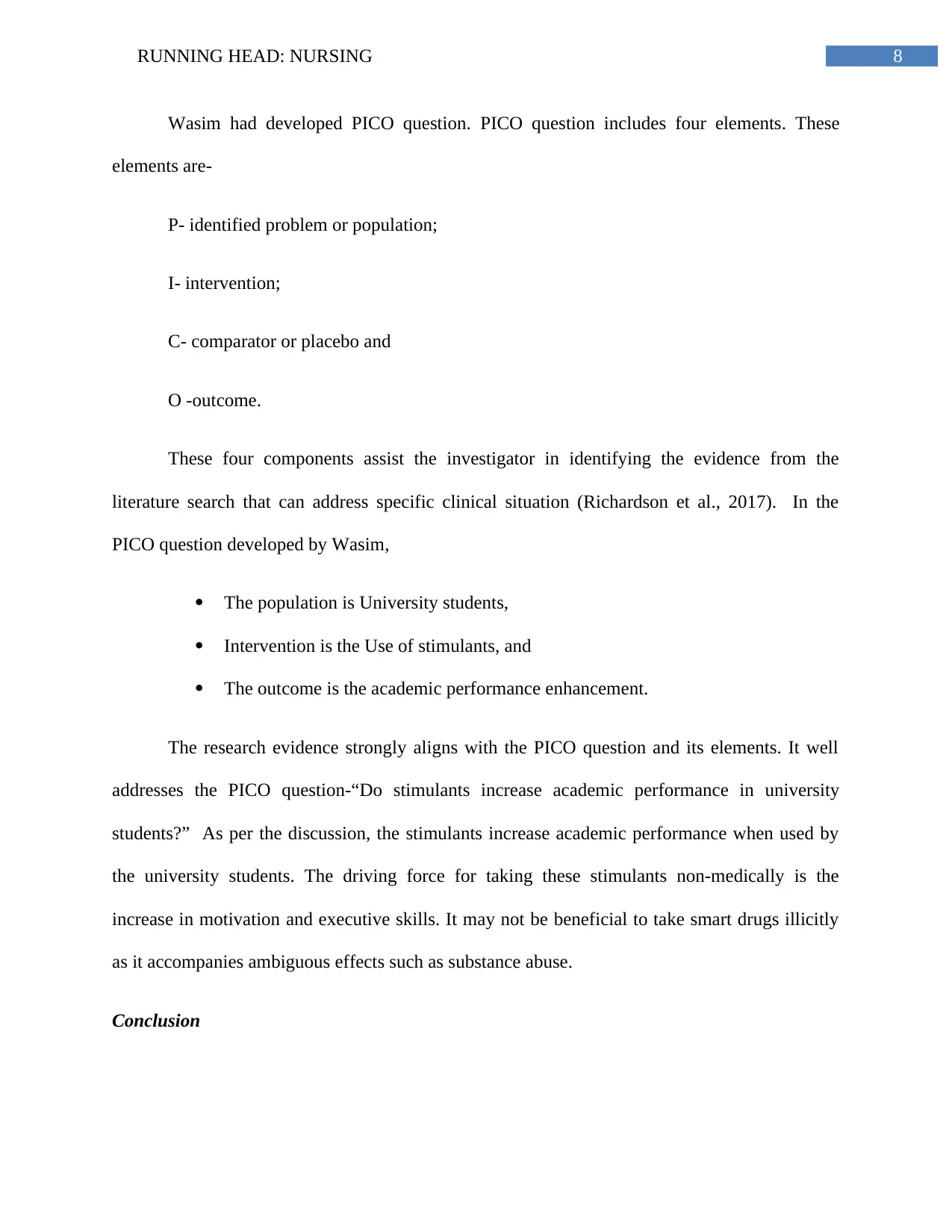
8RUNNING HEAD: NURSING
Wasim had developed PICO question. PICO question includes four elements. These
elements are-
P- identified problem or population;
I- intervention;
C- comparator or placebo and
O -outcome.
These four components assist the investigator in identifying the evidence from the
literature search that can address specific clinical situation (Richardson et al., 2017). In the
PICO question developed by Wasim,
The population is University students,
Intervention is the Use of stimulants, and
The outcome is the academic performance enhancement.
The research evidence strongly aligns with the PICO question and its elements. It well
addresses the PICO question-“Do stimulants increase academic performance in university
students?” As per the discussion, the stimulants increase academic performance when used by
the university students. The driving force for taking these stimulants non-medically is the
increase in motivation and executive skills. It may not be beneficial to take smart drugs illicitly
as it accompanies ambiguous effects such as substance abuse.
Conclusion
Wasim had developed PICO question. PICO question includes four elements. These
elements are-
P- identified problem or population;
I- intervention;
C- comparator or placebo and
O -outcome.
These four components assist the investigator in identifying the evidence from the
literature search that can address specific clinical situation (Richardson et al., 2017). In the
PICO question developed by Wasim,
The population is University students,
Intervention is the Use of stimulants, and
The outcome is the academic performance enhancement.
The research evidence strongly aligns with the PICO question and its elements. It well
addresses the PICO question-“Do stimulants increase academic performance in university
students?” As per the discussion, the stimulants increase academic performance when used by
the university students. The driving force for taking these stimulants non-medically is the
increase in motivation and executive skills. It may not be beneficial to take smart drugs illicitly
as it accompanies ambiguous effects such as substance abuse.
Conclusion
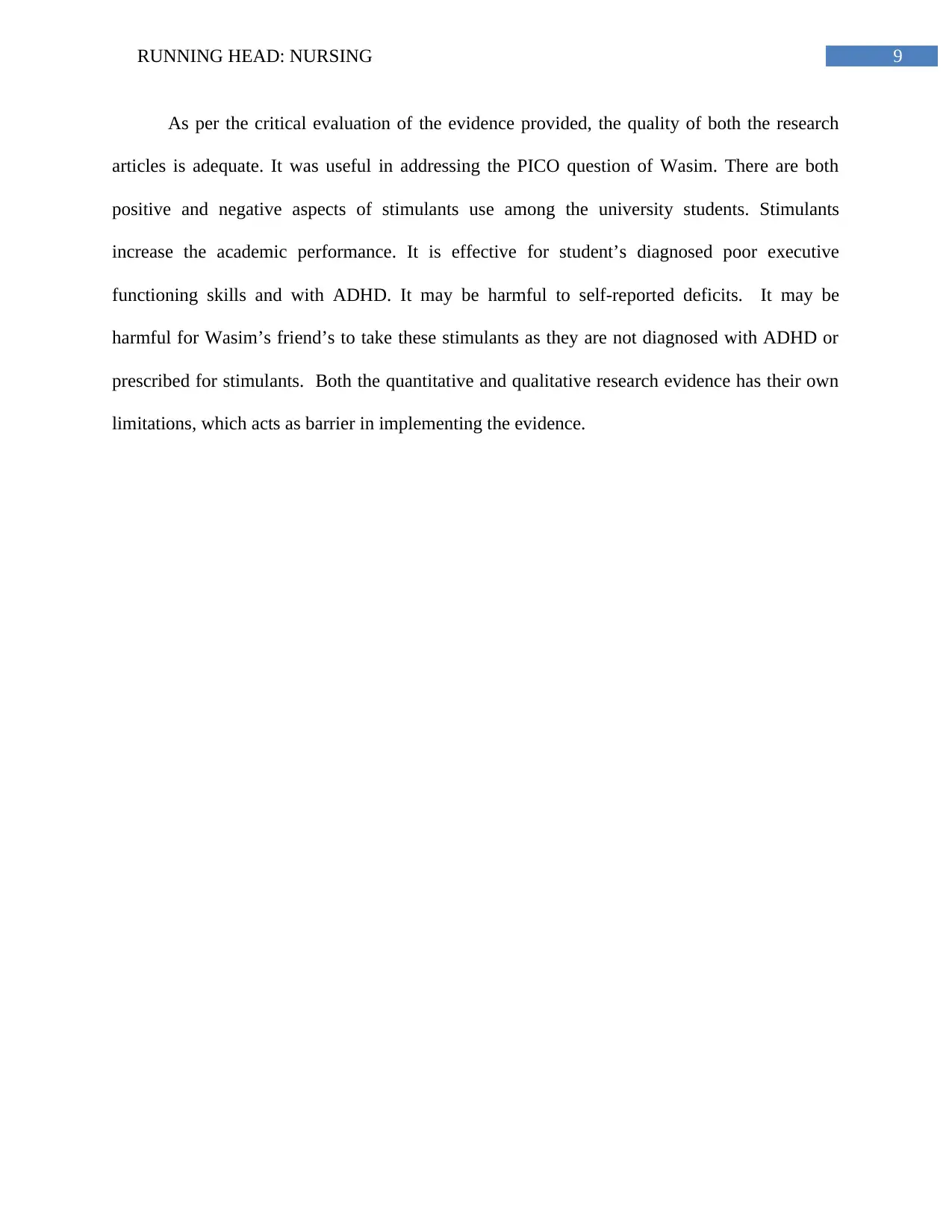
9RUNNING HEAD: NURSING
As per the critical evaluation of the evidence provided, the quality of both the research
articles is adequate. It was useful in addressing the PICO question of Wasim. There are both
positive and negative aspects of stimulants use among the university students. Stimulants
increase the academic performance. It is effective for student’s diagnosed poor executive
functioning skills and with ADHD. It may be harmful to self-reported deficits. It may be
harmful for Wasim’s friend’s to take these stimulants as they are not diagnosed with ADHD or
prescribed for stimulants. Both the quantitative and qualitative research evidence has their own
limitations, which acts as barrier in implementing the evidence.
As per the critical evaluation of the evidence provided, the quality of both the research
articles is adequate. It was useful in addressing the PICO question of Wasim. There are both
positive and negative aspects of stimulants use among the university students. Stimulants
increase the academic performance. It is effective for student’s diagnosed poor executive
functioning skills and with ADHD. It may be harmful to self-reported deficits. It may be
harmful for Wasim’s friend’s to take these stimulants as they are not diagnosed with ADHD or
prescribed for stimulants. Both the quantitative and qualitative research evidence has their own
limitations, which acts as barrier in implementing the evidence.
⊘ This is a preview!⊘
Do you want full access?
Subscribe today to unlock all pages.

Trusted by 1+ million students worldwide
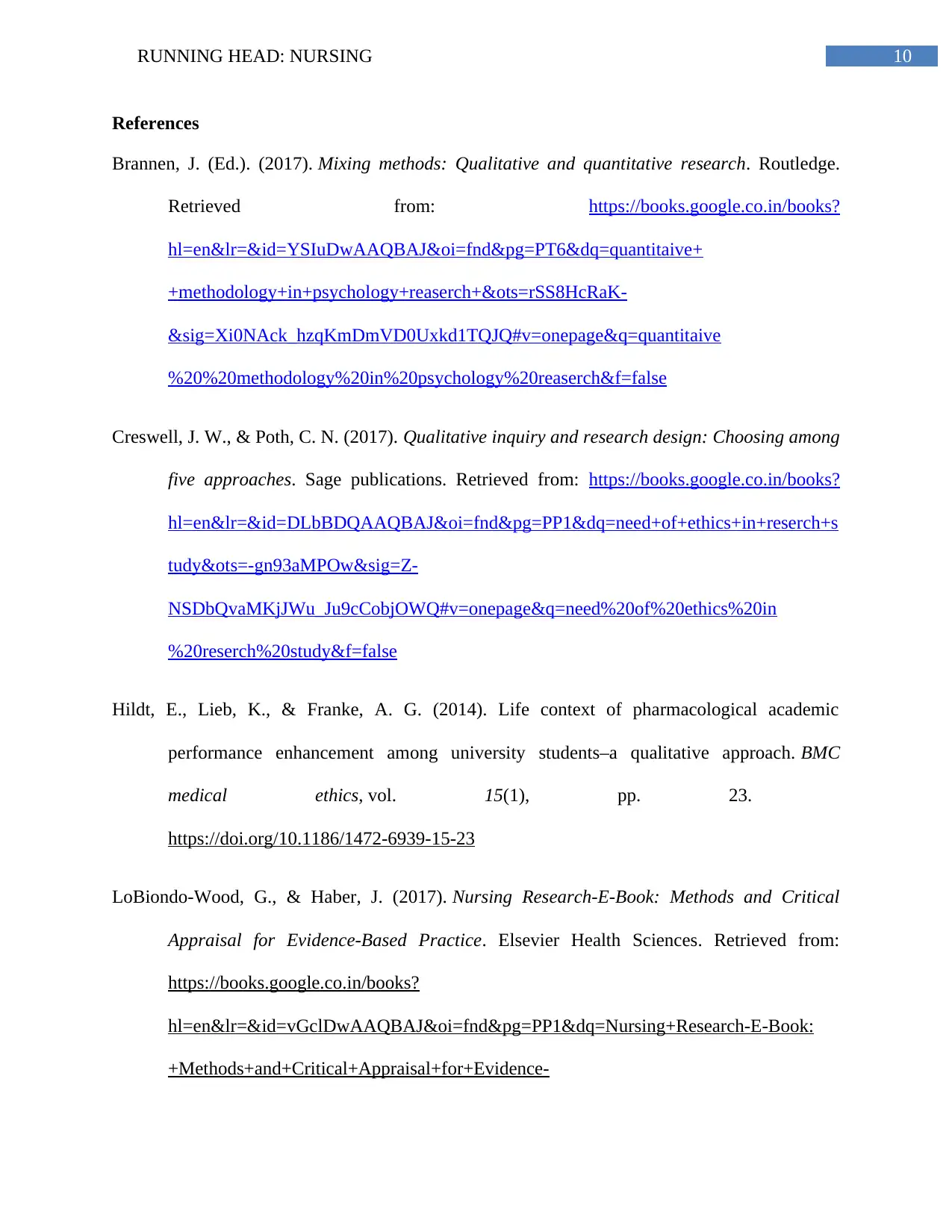
10RUNNING HEAD: NURSING
References
Brannen, J. (Ed.). (2017). Mixing methods: Qualitative and quantitative research. Routledge.
Retrieved from: https://books.google.co.in/books?
hl=en&lr=&id=YSIuDwAAQBAJ&oi=fnd&pg=PT6&dq=quantitaive+
+methodology+in+psychology+reaserch+&ots=rSS8HcRaK-
&sig=Xi0NAck_hzqKmDmVD0Uxkd1TQJQ#v=onepage&q=quantitaive
%20%20methodology%20in%20psychology%20reaserch&f=false
Creswell, J. W., & Poth, C. N. (2017). Qualitative inquiry and research design: Choosing among
five approaches. Sage publications. Retrieved from: https://books.google.co.in/books?
hl=en&lr=&id=DLbBDQAAQBAJ&oi=fnd&pg=PP1&dq=need+of+ethics+in+reserch+s
tudy&ots=-gn93aMPOw&sig=Z-
NSDbQvaMKjJWu_Ju9cCobjOWQ#v=onepage&q=need%20of%20ethics%20in
%20reserch%20study&f=false
Hildt, E., Lieb, K., & Franke, A. G. (2014). Life context of pharmacological academic
performance enhancement among university students–a qualitative approach. BMC
medical ethics, vol. 15(1), pp. 23.
https://doi.org/10.1186/1472-6939-15-23
LoBiondo-Wood, G., & Haber, J. (2017). Nursing Research-E-Book: Methods and Critical
Appraisal for Evidence-Based Practice. Elsevier Health Sciences. Retrieved from:
https://books.google.co.in/books?
hl=en&lr=&id=vGclDwAAQBAJ&oi=fnd&pg=PP1&dq=Nursing+Research-E-Book:
+Methods+and+Critical+Appraisal+for+Evidence-
References
Brannen, J. (Ed.). (2017). Mixing methods: Qualitative and quantitative research. Routledge.
Retrieved from: https://books.google.co.in/books?
hl=en&lr=&id=YSIuDwAAQBAJ&oi=fnd&pg=PT6&dq=quantitaive+
+methodology+in+psychology+reaserch+&ots=rSS8HcRaK-
&sig=Xi0NAck_hzqKmDmVD0Uxkd1TQJQ#v=onepage&q=quantitaive
%20%20methodology%20in%20psychology%20reaserch&f=false
Creswell, J. W., & Poth, C. N. (2017). Qualitative inquiry and research design: Choosing among
five approaches. Sage publications. Retrieved from: https://books.google.co.in/books?
hl=en&lr=&id=DLbBDQAAQBAJ&oi=fnd&pg=PP1&dq=need+of+ethics+in+reserch+s
tudy&ots=-gn93aMPOw&sig=Z-
NSDbQvaMKjJWu_Ju9cCobjOWQ#v=onepage&q=need%20of%20ethics%20in
%20reserch%20study&f=false
Hildt, E., Lieb, K., & Franke, A. G. (2014). Life context of pharmacological academic
performance enhancement among university students–a qualitative approach. BMC
medical ethics, vol. 15(1), pp. 23.
https://doi.org/10.1186/1472-6939-15-23
LoBiondo-Wood, G., & Haber, J. (2017). Nursing Research-E-Book: Methods and Critical
Appraisal for Evidence-Based Practice. Elsevier Health Sciences. Retrieved from:
https://books.google.co.in/books?
hl=en&lr=&id=vGclDwAAQBAJ&oi=fnd&pg=PP1&dq=Nursing+Research-E-Book:
+Methods+and+Critical+Appraisal+for+Evidence-
Paraphrase This Document
Need a fresh take? Get an instant paraphrase of this document with our AI Paraphraser
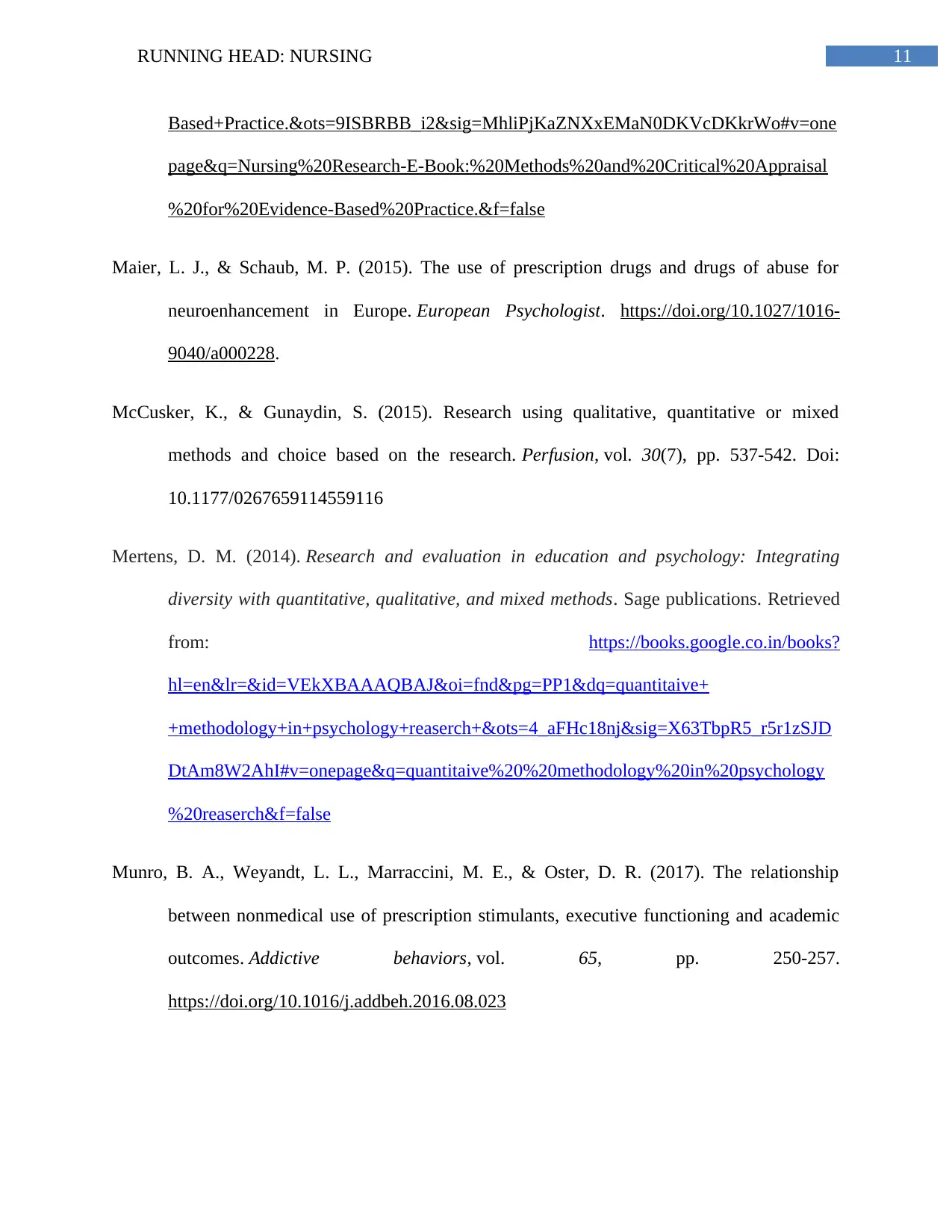
11RUNNING HEAD: NURSING
Based+Practice.&ots=9ISBRBB_i2&sig=MhliPjKaZNXxEMaN0DKVcDKkrWo#v=one
page&q=Nursing%20Research-E-Book:%20Methods%20and%20Critical%20Appraisal
%20for%20Evidence-Based%20Practice.&f=false
Maier, L. J., & Schaub, M. P. (2015). The use of prescription drugs and drugs of abuse for
neuroenhancement in Europe. European Psychologist. https://doi.org/10.1027/1016-
9040/a000228.
McCusker, K., & Gunaydin, S. (2015). Research using qualitative, quantitative or mixed
methods and choice based on the research. Perfusion, vol. 30(7), pp. 537-542. Doi:
10.1177/0267659114559116
Mertens, D. M. (2014). Research and evaluation in education and psychology: Integrating
diversity with quantitative, qualitative, and mixed methods. Sage publications. Retrieved
from: https://books.google.co.in/books?
hl=en&lr=&id=VEkXBAAAQBAJ&oi=fnd&pg=PP1&dq=quantitaive+
+methodology+in+psychology+reaserch+&ots=4_aFHc18nj&sig=X63TbpR5_r5r1zSJD
DtAm8W2AhI#v=onepage&q=quantitaive%20%20methodology%20in%20psychology
%20reaserch&f=false
Munro, B. A., Weyandt, L. L., Marraccini, M. E., & Oster, D. R. (2017). The relationship
between nonmedical use of prescription stimulants, executive functioning and academic
outcomes. Addictive behaviors, vol. 65, pp. 250-257.
https://doi.org/10.1016/j.addbeh.2016.08.023
Based+Practice.&ots=9ISBRBB_i2&sig=MhliPjKaZNXxEMaN0DKVcDKkrWo#v=one
page&q=Nursing%20Research-E-Book:%20Methods%20and%20Critical%20Appraisal
%20for%20Evidence-Based%20Practice.&f=false
Maier, L. J., & Schaub, M. P. (2015). The use of prescription drugs and drugs of abuse for
neuroenhancement in Europe. European Psychologist. https://doi.org/10.1027/1016-
9040/a000228.
McCusker, K., & Gunaydin, S. (2015). Research using qualitative, quantitative or mixed
methods and choice based on the research. Perfusion, vol. 30(7), pp. 537-542. Doi:
10.1177/0267659114559116
Mertens, D. M. (2014). Research and evaluation in education and psychology: Integrating
diversity with quantitative, qualitative, and mixed methods. Sage publications. Retrieved
from: https://books.google.co.in/books?
hl=en&lr=&id=VEkXBAAAQBAJ&oi=fnd&pg=PP1&dq=quantitaive+
+methodology+in+psychology+reaserch+&ots=4_aFHc18nj&sig=X63TbpR5_r5r1zSJD
DtAm8W2AhI#v=onepage&q=quantitaive%20%20methodology%20in%20psychology
%20reaserch&f=false
Munro, B. A., Weyandt, L. L., Marraccini, M. E., & Oster, D. R. (2017). The relationship
between nonmedical use of prescription stimulants, executive functioning and academic
outcomes. Addictive behaviors, vol. 65, pp. 250-257.
https://doi.org/10.1016/j.addbeh.2016.08.023
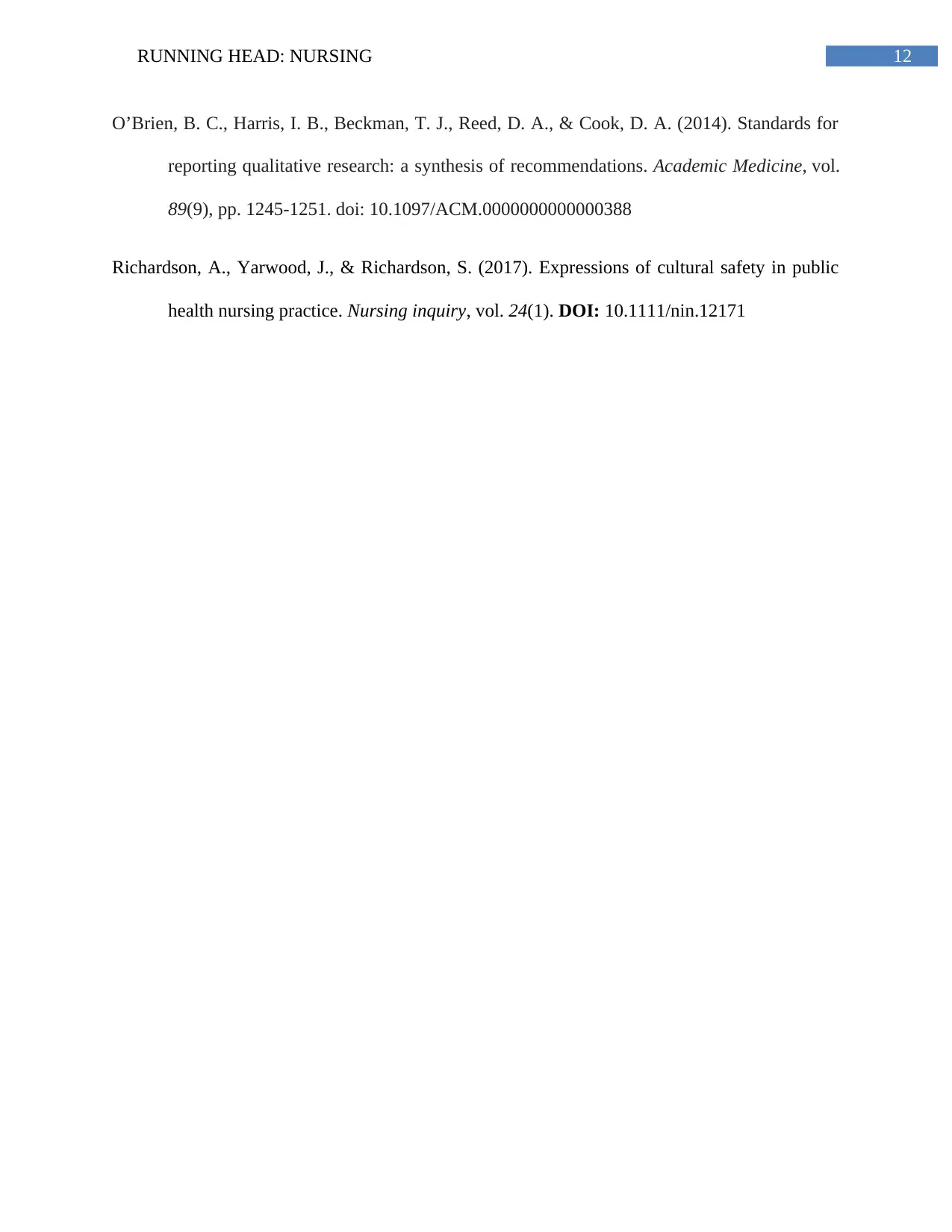
12RUNNING HEAD: NURSING
O’Brien, B. C., Harris, I. B., Beckman, T. J., Reed, D. A., & Cook, D. A. (2014). Standards for
reporting qualitative research: a synthesis of recommendations. Academic Medicine, vol.
89(9), pp. 1245-1251. doi: 10.1097/ACM.0000000000000388
Richardson, A., Yarwood, J., & Richardson, S. (2017). Expressions of cultural safety in public
health nursing practice. Nursing inquiry, vol. 24(1). DOI: 10.1111/nin.12171
O’Brien, B. C., Harris, I. B., Beckman, T. J., Reed, D. A., & Cook, D. A. (2014). Standards for
reporting qualitative research: a synthesis of recommendations. Academic Medicine, vol.
89(9), pp. 1245-1251. doi: 10.1097/ACM.0000000000000388
Richardson, A., Yarwood, J., & Richardson, S. (2017). Expressions of cultural safety in public
health nursing practice. Nursing inquiry, vol. 24(1). DOI: 10.1111/nin.12171
⊘ This is a preview!⊘
Do you want full access?
Subscribe today to unlock all pages.

Trusted by 1+ million students worldwide
1 out of 12
Related Documents
Your All-in-One AI-Powered Toolkit for Academic Success.
+13062052269
info@desklib.com
Available 24*7 on WhatsApp / Email
![[object Object]](/_next/static/media/star-bottom.7253800d.svg)
Unlock your academic potential
Copyright © 2020–2025 A2Z Services. All Rights Reserved. Developed and managed by ZUCOL.





